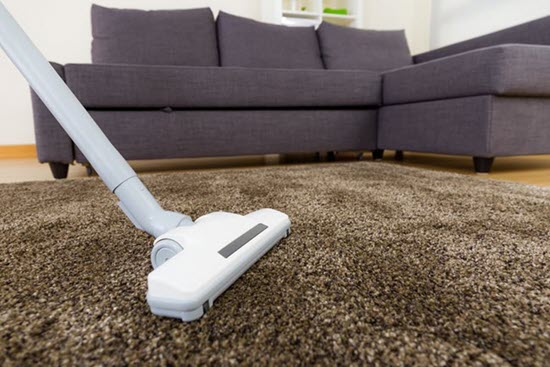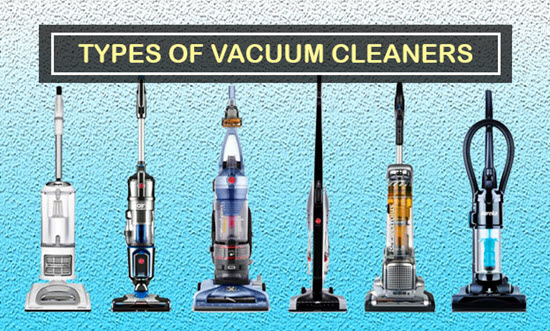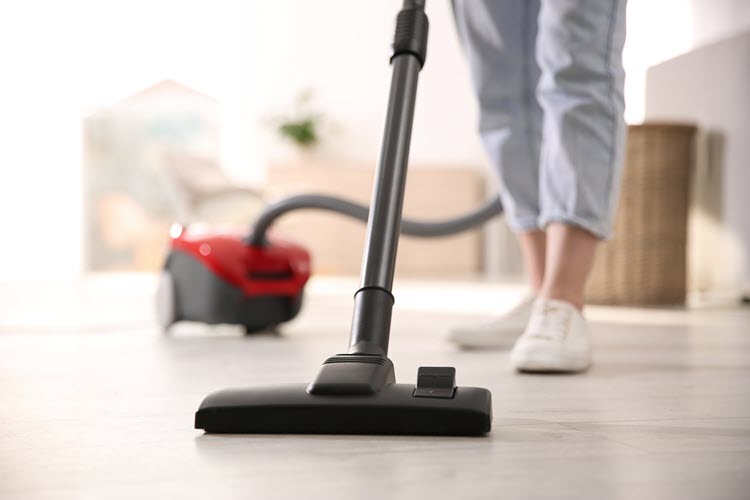When it comes to cleaning, vacuuming is one of those things we all have to do, but no one really likes. It’s not glamorous and you can’t skip it, so how often should you really vacuum? We’ve got the answer for you here!
Vacuuming floors and tile can be a bit of a pain, but it’s also an essential part of maintaining your home. Dust, dirt, and pet dander can affect your air quality and make life difficult for those with breathing issues. You’re probably wondering how often you should vacuum your hardwood floors for the best results.
We’ll break down the frequency for hardwood floors and carpeted floors, and offer some helpful tips to make it easy to stay on top of it.
Vacuum Hardwood Floors Weekly
Hardwood floors are more durable than you might think, but that doesn’t mean you can neglect them for weeks at a time. To keep your hardwood floor looking its best, vacuum it at least once a week with the hose attachment on your vacuum cleaner. This will help prevent buildup and dust from accumulating in your home. Use a soft-bristled broom in between to pick up small messes.
If you ever get a blockage in you vacuum, read “How to Unclog a Vacuum Hose.”
Vacuum Carpets or Rugs Twice Per Week
The more often you vacuum, the less dust and debris will be tracked into your home. This means that you’ll need to vacuum carpets and rugs twice a week. Vacuum upholstered furniture as needed to remove hair or dander before it accumulates on the fabric.

If allergies are an issue, it’s best to vacuum when there’s no one else around and open the window to let in the fresh air.
Vacuum More Often If You Have Pets
If you have pets, you’re probably vacuuming more than the average person. Pets are notorious for shedding fur, which can be a breeding ground for allergen-producing microorganisms.
If you have pets and want to minimize the number of allergens in your home, then there are a few things to keep in mind:
- How often should you vacuum with pets? If you have one pet cat or dog that lives indoors only and doesn’t shed a lot of hair—once per week is fine.
- If you have more than one pet and they shed a lot, you may want to vacuum every other day or daily, depending on how much hair they shed.
How Often to Vacuum by Room
- Hallways, kitchens, kids’ playrooms, and other high-traffic areas should be vacuumed at least once a week.
- Bedrooms should be vacuumed at least once a week, and twice during allergy season.
- For spaces such as guest rooms, sunrooms, and formal dining rooms—which aren’t used daily but still need to be kept tidy—vacuum once a month or just before guests arrive.
Best Practices for Keeping a Clean Home
Let’s start with the basics. The cleaner your carpets stay, the less often they need to be shampooed.
It doesn’t take much time or effort to keep your home clean, but it does require vigilance. If you’re busy with work or school, set aside a few minutes each day to make your bed, pick up and put away, and sweep —or hire a professional cleaner!
Even if you vacuum your rug once or twice a week, it’s important to do regular sweeping of any hard floors as well. Sweeping will catch the dirt that gets tracked in on your shoes before it gets into your carpet.
Along with sweeping and vacuuming, getting a doormat can also help your floors stay cleaner. If you get in the habit of wiping your feet before entering, it will keep a lot of that dirt from getting into your house.
What Type of Vacuum Do I Need?
As a homeowner, you know the importance of having the right cleaning tools for the job. When it comes to vacuums, there are types that work best for bare floors and some that work best for carpeting, as well as some that work well for both. You’ll have to do some research on these different vacuum types to find the one that will best fit your needs.

Here are some of the most common types of vacuums:
- Handheld Vacuum: A handheld vacuum is a small, portable device that can be used for cleaning up messes in small areas like kitchens or bathrooms. They’re great for everyday use because they’re so easy to store and carry around.
- Canister Vacuum: A canister vacuum is a more traditional style of vacuum that sits on the floor instead of being handheld. They are generally larger than handheld vacuums and often have more features like attachments for cleaning furniture, stairs, or other areas that may be inaccessible with lighter-weight models.
- Upright Vacuums: Upright vacuums are the kind most people think of when they hear “vacuum cleaners.” Uprights offer more suction power than handhelds, and they’re great for deep cleaning carpets, rugs, and floors. They’re also much more powerful than canister vacuums because they have larger motors with more suction power. For more on upright vacuums, read our reviews of the best corded stick vacuums.
Tips for finding the right vacuum for hardwood or tile floors:
Get a vacuum that is designed specifically for hardwood, tile or laminate floors. These vacuums will be gentle on your floors without causing any damage. If you don’t want to incur the expense of a second vacuum, you can also use a canister or upright vacuum with the brush attachment to reach into corners.
You should also consider investing in a steam mop if you don’t already have one. Steam mops provide deep cleaning for your floors without requiring a lot of elbow grease. This makes them ideal for smaller homes where there isn’t much room for heavy equipment like floor buffers or hand-held steam cleaners.
Tips for finding the right vacuum for carpets or rugs:
Make sure your vacuum has a rotating brush attachment. You’ll get better results with one than without it—and your carpet will last longer.
Vacuum in different directions: If you’re vacuuming a rug, it’s important to move in different directions while doing so. For example, start at one end of the rug and move towards the other side of it at an angle. Then go back over that part again at a different angle before moving on to another section of the rug.
Finally, always make sure that your vacuum has filters so dust doesn’t get sucked into your home again after being cleaned up!
So, the question of how often to vacuum depends on the type of floors you have and your lifestyle.
Wondering if you should dust first or vacuum first? Always dust first, then vacuum.


